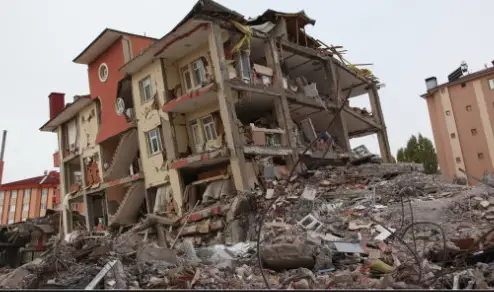
WHAT IS AN EARTHQUAKE ?
Earthquakes and volcanoes are some of the most dangerous and spectacular natural hazards on our planet. They have been happening for millions of years, and will continue to do so.
Scientist say that more than a million earthquakes rattle the world each year. Earthquakes causes shock waves to shake the surface of the Earth.
This movement largely takes place at the dividing line where the Earth’s Plates (tectonic plates) meet, by either colliding, or by sudden movement.
Sometimes the movements of these plates releases red-hot molten rock to burst up through the Earth’s crust, and with enormous pressure building beneath the surface of the earth, this forces this magma upwards into a spectacular explosion, creating a volcano.
WHAT CAUSES AN EARTHQUAKE ?
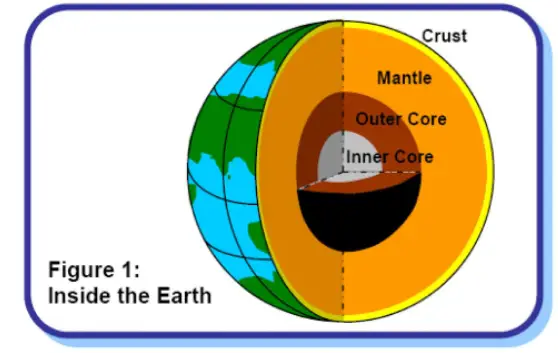
If we could dig through the Earth’s surface right in the center, we would find four different layers. It’s the activity in these layers beneath the Earth’s surface that creates earthquakes and volcanoes.
From the center outwards, the Earth’s layers are, the inner core, the outer core, the mantle, and the crust. We live on the crust, and this is the layer we know most about.
The Earth’s crust contains around 15-20 tectonic plates, which are all moving in different directions, and at different speeds. Some of these plates are so big that they cover entire continents. When these plates crash together, pull apart, or get jammed together and suddenly become free, this creates an earthquake.
The movement of these big massive rocks (Plates) in the ground, is called the Fault Line.
EARTH’S FOUR DIFFERENT LAYERS !!!
THE INNER CORE –
This has a radius of about 1,220 kilometers and is mainly composed of solid iron and nickel.
THE OUTER CORE –
This is a fluid layer about 2,400 kilometers thick and is mainly composed of semi-molten iron and nickel.
THE MANTLE –
The mantle is about 2,900 kilometers thick and has an average temperature of 3000° Celsius. It is mostly composed of solid, very dense rock.
THE CRUST –
The crust is made of two types, oceanic and continental. Oceanic crust forms the sea bed and is made up of dense rock called basalt. The continental crust sits on top of the oceanic crust and is up to 80 km thick and mostly composed of granite.
PLATE TECTONICS / TECTONIC PLATES !!!
Plate tectonics is a theory or idea developed in the 1960’s, about the Earth’s plates, in how they were formed, how they move, and the results of their movements. All of Earth’s water and land sit on these plates.
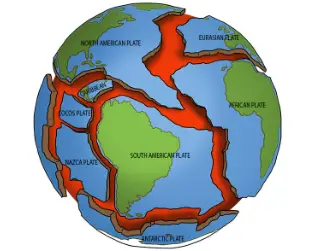
Tectonic plates are composed of solid rock, while under the plates is a weaker layer of dense melted rock. It’s between these two boundaries, that the plates, which are constantly moving over the weaker layer, that the most dramatic earthquake and volcanic action happens.
For example, if two plates are sliding past and over each other, massive friction stores energy within the plates. The plates can become stuck to each other, and it’s only when they finally pull apart, we experience an earthquake on the Earth’s surface.
FAULT / FAULT LINE !!!
A fault is a crack in the rocks (plates) of the Earth’s crust where earthquakes form.
A fault line is where the rocks (plates) are sliding past each other, vertically or horizontally, causing a crack in the Earth’s surface. This is where earthquakes are likely to occur.
SEISMIC WAVES !!!
The shifting rock in an earthquake causes vibrations, which are called seismic waves. These waves can travel through the Earth’s inner layers or travel along the surface of the planet.
There are three different types of earthquake waves, which all travel at different speeds, while also causing massive destruction to property.
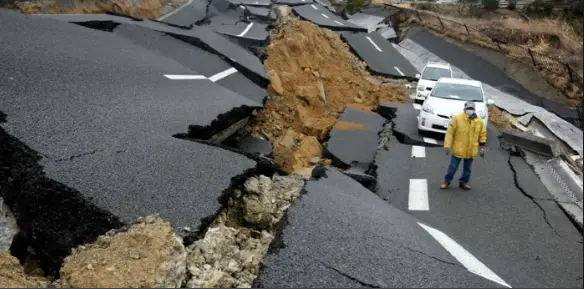
On one occasion, after a earthquake hit Mexico city in 1985, the seismic waves made the ground wobble like jelly, causing many buildings to collapse, yet it was far away from the epicenter, so it should have been fairly safe.
The epicenter is the point on the Earth’s surface which is directly above where an earthquake, or underground explosion originates. It is also the geographical location of the earthquake when reported on television stations.
The hypocenter is quite the opposite of the epicenter, as this is the point where the earthquake starts below the surface of the Earth.
DIFFERENT SEISMIC WAVES !!!
(1) P Waves –
Primary or push waves. These are the fastest waves that start at the focus, but then they move in different ways.
(2) S Waves –
Secondary or shake waves. These fast waves move from side to side, shaking the ground back and forth.
(3) L Waves –
Longitudinal surface waves. These are the slowest waves that move close to the surface, but can be very destructive, due to it’s high amplitudes.
MEASURING EARTHQUAKES !!!
Scientists use an instrument called a “seismograph” to record and measure earthquake waves. They also use an instrument called a “seismometer,” which is a very sensitive piece of equipment that can detect movements of the Earth’s surface.
THE RICHTER SCALE !!!
The most common way to measure an earthquake was devised by Charles Richter in 1979, aptly named, the Richter Scale. This measures the magnitude of an earthquake, or how powerful it is.
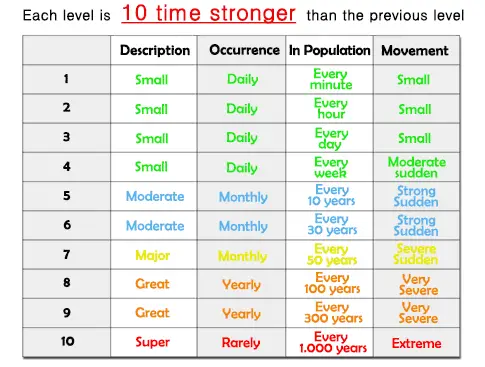
A Richter scale is normally numbered from 1-10. As it is a logarithmic scale, this means that each point is ten times greater than the one below it. For example, an earthquake measuring a magnitude of 5, is ten times more powerful than an earthquake measuring 4, and 100 times more than a magnitude 3, and a 1000 times more than a magnitude 2, and so on.
Earthquakes measuring 1-2 on the Richter scale happens frequently, and are so small, you probably would not even notice it.
Earthquakes measuring 7 and upwards are less frequent, but are major and very powerful, causing a lot of damage.
THE MERCALLI SCALE !!!
The Mercalli scale measures the intensity of shaking and the damage produced by an earthquake.
This scale does not need any instruments, as it’s all done by observation.
The scales has 12 ratings, ranging from number (1)- people do not feel any movement, to number (4)- parked cars rocking, to number (8)- drivers having trouble steering, or branches breaking off trees, to number (12)- almost everything is destroyed with the ground moving like waves.
SHORT FACTS ON EARTHQUAKES !!!
Earthquakes can cause huge waves in the oceans, called Tsunamis.
Tectonic plates are around 62 miles (99 km) thick.
The movement of the plates creating an earthquake has formed large mountains, such as the Andes and the Himalayas.
Due to the movement of the plates, the jigsaw puzzle of Earth’s continents hasn’t stopped shifting. For example, the Pacific Ocean is shrinking year by year, while the Atlantic Ocean is widening, pushing the Americas away from Africa and Europe.
Normally before and after a large earthquake, you would get smaller earthquakes, the ones before are called foreshocks, and the ones after are called aftershocks.
One of the most powerful earthquakes ever recorded on Earth was in Valdiva, Chile, in 1960. It measured 9.5 on the Richter Scale.
Around 10,000 people on average die in earthquakes every year.
80% of the worlds earthquakes happen in an area called the “Ring Of Fire,” in the Pacific Ocean, close to Japan.
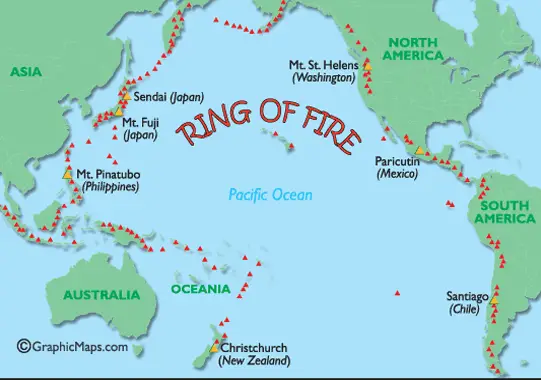
The deadliest known earthquake happened in China in the year 1556, killing around 830,000 people.
Southern California has around 10,000 earthquakes every year, although very few are even felt.
Magnitude is the amount of energy released during a earthquake.
Scientists estimate that there are around 500,000 detectable earthquakes in the world every year. Only about 100,000 can be felt, and of these, 100 can cause damage.
Most Earthquakes happen at depths of less than 50 miles from the Earth’s surface.




